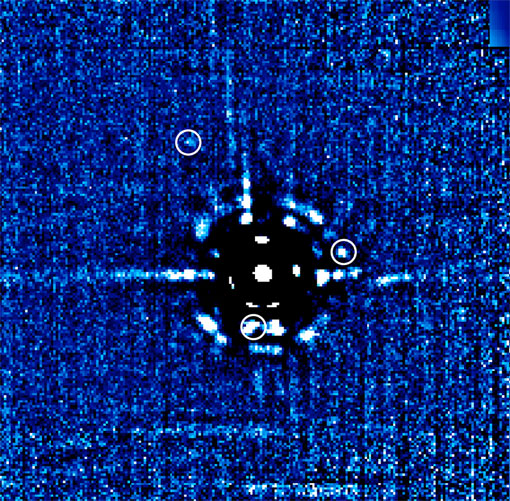| 2013 / | 2012 / | 2011 / | 2010 / | 2009 / | 2008 / | 2007 / | 2006 / | 2005 / | 2004 / |
| 2003 / | 2002 |
| Ein Exoplanet aus einer anderen Galaxie Astronomen haben den ersten Exoplaneten entdeckt, der aus einer anderen Galaxie stammt. An exoplanet from another galaxy stronomers have discovered the first exoplanet that originated in another galaxy. PR 10-11-18 |
|
| Neues astronomisches Phänomen: »Kernschein« gibt Einblicke in früheste Phase der Sterngeburt New astronomical phenomenon: Coreshine provides insight into stellar births PR 10-09-23 |
|
| Kovalevskaja-Preis 2010 für Joseph Hennawi Dr. Joseph Hennawi vom MPIA in Heidelberg erhält einen der höchstdotierten Wissenschaftspreise Kovalevskaja Award 2010 for Joseph Hennawi Joseph Hennawi of the MPIA in Heidelberg is a recipient of the 2010 Sofja Kovalevskaja Award PR 10-09-22 |
|
| Spirale frisst Zwerg: Umrankte Galaxien liefen neue Informationen über die Evolution von Spiralgalaxien. Spirals eat dwarfs: Galactic tendrils shed light on evolution of spiral galaxies PR 10-09-07 |
|
| Otto Hahn Medaille für Surhud More Dr. Surhud More ist einer der Empfänger der diesjährigen Otto-Hahn-Medaillen. Otto Hahn Medal for Surhud More One of the recipients of this year's Otto Hahn Medal is Dr. Surhud More. PR 10-06-18 |
|
| Observatorium dreht »Himmels-Film«: Pan-STARRS beginnt systematische Durchmusterung Das Projekt Pan-STARRS hat mit einzigartigen Beobachtungen großer Teile des Nachthimmels ... Astronomers' first "movie of the sky": Pan-STARRS survey starts science mission The Pan-STARRS project has begun a unique program of observing three quarters of the night sky: ... PR 10-06-16 |
|
| Durchbruch für das Large Binocular Telescope: das LBT liefert schärfere Bilder als Hubble Dank einer neuen Generation der adaptiven Optik am Large Binocular Telesope (LBT) auf dem Mount Graham in Arizona verfügen Astronomen nun ... Large Binocular Telescope Achieves Major Breakthrough Using Adaptive Optics New Technology Brings Space Telescope Image Quality Down to Earth, Offering Astronomical Image Clarity Never Seen Before ... PR 10-06-15 |
|
| Kosmische Geschwindigkeitskontrolle offenbart überraschend unruhigen massereichen Sternhaufen Mit Hilfe des NASA/ESA-Weltraumteleskops Hubble haben Astronomen des MPIA in Heidelberg und der Universität zu Köln ... Stars in Motion: High precision follow-up study of star movement shows surprising unrest in massive star cluster Using the NASA/ESA Hubble Space Telescope, astronomers from the MPIA in Heidelberg and the University of Cologne ... PR 10-06-02 |
|
| Weltraumteleskop HERSCHEL: Erfolgreiches erstes Jahr für deutsche Forscher Ein Jahr nach dem Start des ESA-Weltraumteleskops HERSCHEL ziehen deutsche Wissenschaftler eine positive Bilanz. ... PR 10-05-06 |
|
| Das Unsichtbare sichtbar machen Ein neues Arbeitspferd für das größte optische Teleskop der Welt ... Making the invisible visible New workhorse for the world´s largest optical telescope ... PR 10-04-21 |
|
| Feuer ohne Rauch: Auf den Spuren der urtümlichsten Schwarzen Löcher Astronomen haben zwei Schwarze Löcher aufgespürt, die sich in einem extrem frühen Stadium ... Fire without smoke: Tracking down the most primitive black holes in the universe Astronomers have found what appear to be the two most primitive black holes in the universe ... PR 10-03-17 |
|
| Neue Methode erschließt Exoplanetenchemie auch kleineren Teleskopen Eine Gruppe von Astronomen, der auch Forscher des Max-Planck-Instituts für Astronomie angehören ... Probing exoplanet chemistry without the need for space telescopes A group of astronomers, which includes researchers from the Max Planck Institute for Astronomy ... PR 10-02-04 |
|
| Erster direkter »chemischer Fingerabdruck« eines Exoplaneten, der einen sonnenähnlichen Stern umkreist Astronomen ist es gelungen, die erste Direktmessung eines Spektrums – eines »chemischen Fingerabdrucks« – für einen Planeten vorzunehmen ... First Direct “Chemical Fingerprint” of an Exoplanet orbiting a Sun-Like Star Astronomers have obtained the first direct spectrum – a “chemical fingerprint” – of a planet orbiting a distant, Sun-like star ... PR 10-01-13 |
 |
Verantwortlich / Responsible: Axel M. Quetz
Letzte Änderung / Last update: 14. April 2014